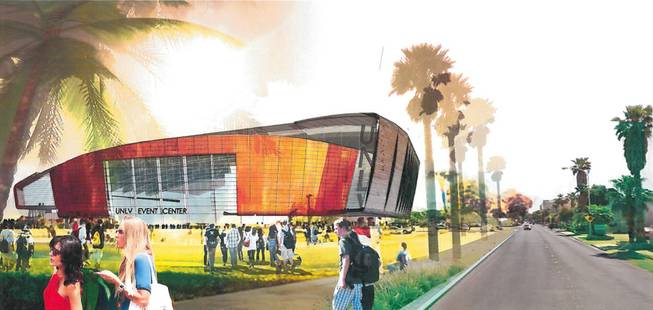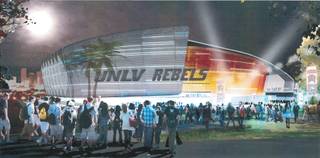
Courtesy
Artist rendering of the proposed UNLV Now project.
Tuesday, Oct. 2, 2012 | 2 a.m.
Related stories
- Take a closer look at stadium proposals in and around Las Vegas in the Sun's Racing to Build Vegas' next venue report from July 15.
Cost and location plans for a domed, 60,000-seat “mega-event” stadium on the UNLV campus are coming into sharper focus two months before a review by the university system’s Board of Regents.
With a traffic study for the joint venture of UNLV and Majestic Realty Co. still being completed, sources place the stadium at the site of the current UNLV baseball facility, north of Harmon Avenue and east of Swenson Street. The baseball field would be moved south, between Harmon and Tropicana avenues.
The stadium’s cost is estimated around $800 million, with about one-third, or about $270 million, coming from long-term naming rights and numerous forms of advertising. Another third would come from revenue generated at the site; the last third would come in the form of a sort of tax-incremental financing plan, which would help developers obtain long-term financing.
The Legislature will be asked to approve the tax-incremental financing plan in 2013.
Don Snyder, known for leading the effort to build the Smith Center for the Performing Arts, the largest public/private venture in Nevada, said the stadium cost may go higher than $800 million when other infrastructure components such as parking and relocations are added.
Snyder said UNLV President Neal Smatresk asked him in June to provide project leadership on behalf of the university.
“I’m excited by the fact that this will be on the UNLV campus,” Snyder said. “It’s a game-changer for Las Vegas as a whole — for Las Vegas as a destination and for the university, and that’s a two-fer in my book. And I can’t think of a better bridge between UNLV and the community. It almost becomes a three-fer.”
Earlier plans placed the stadium further south toward Tropicana Avenue, but concerns about interfering with air traffic into McCarran International Airport forced the move to the north, sources said.
A key component to the plan is obtaining more than 20 acres of land currently listed as property of the Clark County Department of Aviation. The land is north of Tropicana Avenue at Paradise Road. Soccer fields displaced by the stadium project would be relocated there.
Snyder, who is dean of UNLV’s College of Hotel Administration, said the land, now mostly a barren patch of dirt and sand, would become something of a “front door” to the campus, which millions of tourists will see as they churn out of McCarran on their way to the Las Vegas Strip.
Clark County Commissioner Steve Sisolak said he “hopes the plan works” but added he wanted to be sure traffic issues would be addressed.
“There’s no liability on behalf of taxpayers, so my only concern right now is traffic,” he said. “Because currently if you go to a Rebel (basketball game) at the Thomas & Mack, I’ve been on Tropicana where it’s been backed up three-quarters of a mile, which can create problems for people trying to get to the airport.”
Ultimately, the stadium would become the cornerstone of a development currently called UNLV Now that includes 5,000 to 10,000 living units for college students and an on-campus retail/entertainment district.
UNLV Athletic Director Jim Livengood said Monday that plans were “moving ahead.”
“In other words, there’s no slowdown,” he said. “There are a lot of moving parts. We are not at the stage where a lot of things are going public. But certainly in the next 75 to 90 days, a lot more will be known.”
Regents will review plans during meetings scheduled Nov. 29-30 at UNLV.
While the stadium would be the home field for UNLV football and likely play a key role in recruiting efforts for the university’s football program, there are only six to seven home games per year. Project developers refer to the stadium — which previously had a planned capacity of 50,000 seats — as a mega-events center instead of a football stadium because of the numerous events they hope to attract. Some of those mentioned include international and Major League Soccer games, concerts, corporate events, NCAA football bowl games, and UFC and boxing matches.
Long after the developers are gone, Snyder said, he believes the project will “define the campus in a much more progressive way for several generations.”
“These projects are tough, and it’s easier not to do them than it is to do them,” he said. “But when people look at it and see that it really does make sense, it doesn’t make it any easier, but it certainly makes it worthwhile.”
Sun Sports Editor Ray Brewer contributed to this story.


Join the Discussion:
Check this out for a full explanation of our conversion to the LiveFyre commenting system and instructions on how to sign up for an account.
Full comments policy